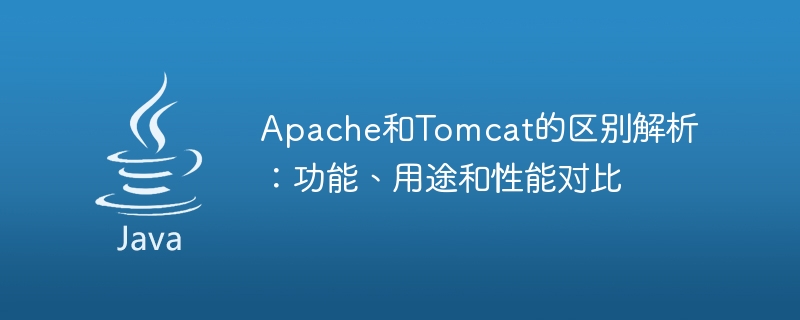Home >Java >javaTutorial >Compare the differences between Apache and Tomcat: functions, uses and performance analysis

Apache and Tomcat are two commonly used open source software for building and managing web servers. Although their common goal is to support the operation of web applications, they have some differences in functionality, purpose, and performance.
First, let’s take a look at their functions. Apache is a powerful web server software that supports multiple protocols, including HTTP, HTTPS, FTP, SMTP, etc. Apache also provides many modules that extend its functionality, such as modular authentication and access control, caching, compression, and logging. In addition, Apache also supports virtual hosts, which can map multiple domain names to the same server.
Tomcat, on the other hand, is a Servlet container used to run Java web applications. It is a project of the Apache Foundation and is part of the Java EE specification. Tomcat supports technologies such as Java servlet, JavaServer Pages (JSP) and Java WebSocket, which can be used to build dynamic and scalable Web applications. Tomcat also provides many management tools to facilitate users to monitor and manage the operation of web applications.
In addition to functions, there are also some differences in usage between Apache and Tomcat. Apache is mainly used for the transmission and processing of static content. It can customize the transmission methods and processing rules of various types of static files (such as HTML, CSS, images, etc.) through configuration files. Apache can also forward requests to other servers through reverse proxies and supports load balancing and high availability configurations. Therefore, Apache is suitable for web applications that need to handle large amounts of static resources.
In contrast, Tomcat is mainly used for dynamic content processing. It executes dynamic pages such as Java servlets and JSP through the Servlet container, can generate dynamic content according to user requests, and interact with databases and other back-end services. Tomcat can also manage web application related functions such as sessions and user authentication. Therefore, Tomcat is suitable for web applications that require dynamic data processing.
Finally, let us compare the performance differences between Apache and Tomcat. Since Apache is a general-purpose web server software that faces different types of requests and clients, it performs well in handling static content. On the other hand, since Tomcat is a Servlet container specifically designed to execute Java web applications, it has better performance for handling dynamic content. This is because Tomcat is optimized for Java technology and uses technologies such as thread pools and connection pools to improve concurrency performance.
In general, there are some differences between Apache and Tomcat in terms of functions, uses and performance. Apache is suitable for scenarios such as handling static content and reverse proxy, while Tomcat is suitable for executing Java web applications and processing dynamic content. Therefore, when choosing which software to use, you need to decide based on actual needs. At the same time, Apache and Tomcat can be used together to implement more complex web applications. By using Apache as a front-end proxy server, handing over static resources to Apache for processing, and handing over dynamic content to Tomcat for processing, you can give full play to the advantages of both and improve overall performance and stability.
The above is the detailed content of Compare the differences between Apache and Tomcat: functions, uses and performance analysis. For more information, please follow other related articles on the PHP Chinese website!